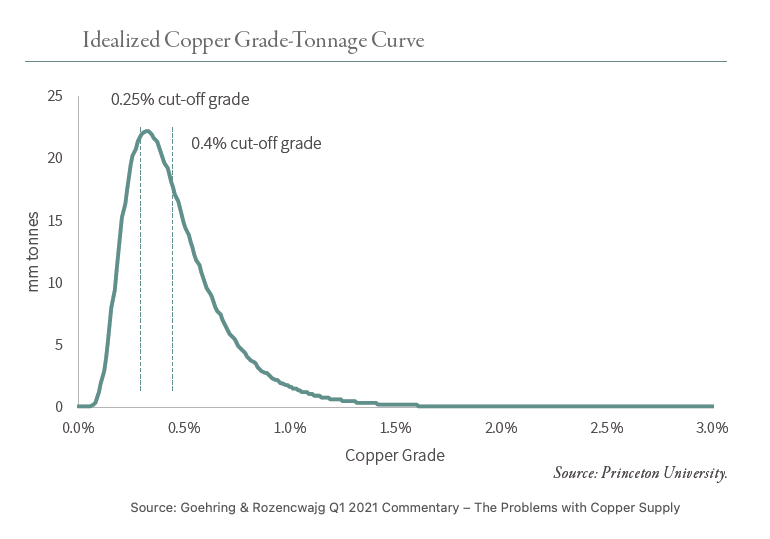New bull chart for $30,000 copper price: porphyries nearly mined out

Predictions for copper at double or triple today’s level is a fairly recent phenomenon – and bears still outnumber bulls as to what’s next for the bellwether metal.
Wall Street natural resource investment house Goehring & Rozencwajg Associates confirmed their place in the superbull camp this week, predicting a copper price north of $30,000:
“The previous copper bull market took place between 2001 and 2011 and saw prices rise seven-fold: from $0.60 to $4.62 per pound. The fundamentals today are even more bullish.
“We would not be surprised to see copper prices again advance a minimum of seven-fold before this bull market is over. Using $1.95 as our starting point, we expect copper prices to potentially peak near $15 per pound by the latter part of this decade.”
The rosy demand side for copper has been well documented and Goehring & Rozencwajg focuses on supply, specifically depletion in their latest commentary.
Depletion, surprisingly, is not discussed that often in the industry and according to the authors is little understood, despite its fundamental importance for long-term supply trends.
Low and declining grades, uninspiring green and brownfield discoveries (with a few exceptions) and thin, slow project pipelines have become rules of thumb in the copper mining industry.
To those issues, the report adds copper miners’ habit of high-grading (mining your best quality ore first) and growing your reserves with a simple ploy – lowering cut-off grades when prices rise.

Even with prices well above $10,000 a tonne, these paper reserves cannot keep growing, according to Goehring & Rozencwajg, specifically at porphyry deposits which produce 80% of the world’s copper.
The authors have calculated an industry average cut-off grade of 0.25%, down from 0.4% in the mid-2000s when the firm first started tracking producers’ reserve calculations at 115 mines across the globe responsible for four-fifths of total output.
“The copper industry’s ability to increase its reserve base by lowering its cut-off grade is nearing an end, regardless of how high copper prices go. It is a complicated but very important subject based on how copper porphyry deposits are geologically formed.
“Lowering the cut-off grade clearly cannot go on indefinitely; unlike interest rates there is a firm low at zero. More important, the log-normal shape of the grade-tonnage plot means that most of the reserves have likely already been added.
“Most reserves are located on the right side of the mean where the grade-tonnage curve has a long tail. On the left hand side of the mean, the log-normal distribution shows that the grade-tonnage curve has a very short tail with far few reserves.”
Click here to take a deep dive at Goehring & Rozencwajg.
RELATED: Freeport’s Grasberg go-go days back as gold, copper prices rally
RELATED: Ivanhoe’s Congo mine productivity peerless among copper giants
{{ commodity.name }}
{{ post.title }}
{{ post.date }}

7 Comments
R Diogo
Speculation and a flood of fresh printed ? USD is driving the prices higher.
This predictions of sky high futures from people with a specific agenda lack reality.
80 to 95% of all copper produced has been and will RECYCLED.
The growth of electrification is being done using Aluminium
Copper is destined to thin wiring cars electronics ..small stuff.
Copper prices will plunge the day after FED raises or signals the rate rise….
Batcher1
Disagree copper output and discoveries are not keeping pace with where the world I going.
Government stimulus to increase productivity and get economies improved due to covid 19 will increase the use and manufacturing of copper.
New techs EV and infrastructure development as well as defence appliances are all putting strain on prices. China’s growth will continue and India will be gaining economic strength in coming years after vaccines are fully implemented.
Murrstir
Too funny. Copper won’t be alone in that plunge.
SK Sachdeva
Copper demand will rise in future as EV is the future which consume 65 to 100 kg copper.
Jeffrey Sawicki
They’ll just use aluminum to replace copper
Tin is the real winner with the semiconductor computer chips boom. Lots of soldering going in
Zig Lambo
There is still quite a bit of copper out there that hasn’t been developed and yet would be reletively easy to do in decent locations. A good example is Whipsaw next to Copper Mountain in BC. Based on previous work, there could be over 500 MT there for easy development at over $50/t current metals prices. There are also others in BC.
Devin
I’m an electrician and use 1000s of pounds of copper every year on infrastructure of commercial buildings. Aluminum is a poor conductor and loses more energy at longer distances than copper. It won’t replace copper on low voltage applications. Besides line voltage IE power grids or high voltage lines copper is almost exclusively used. Recycling is usually just what’s left over from the job, a lot of times old cables are just abandoned in the buildings, I’ve seen cables from the early 1900s with fabric insulation in buildings it was copper they used back then too. It cost money to demo out the old cables so owners just leave them. Cable prices are rocketing and scrap cost is too.